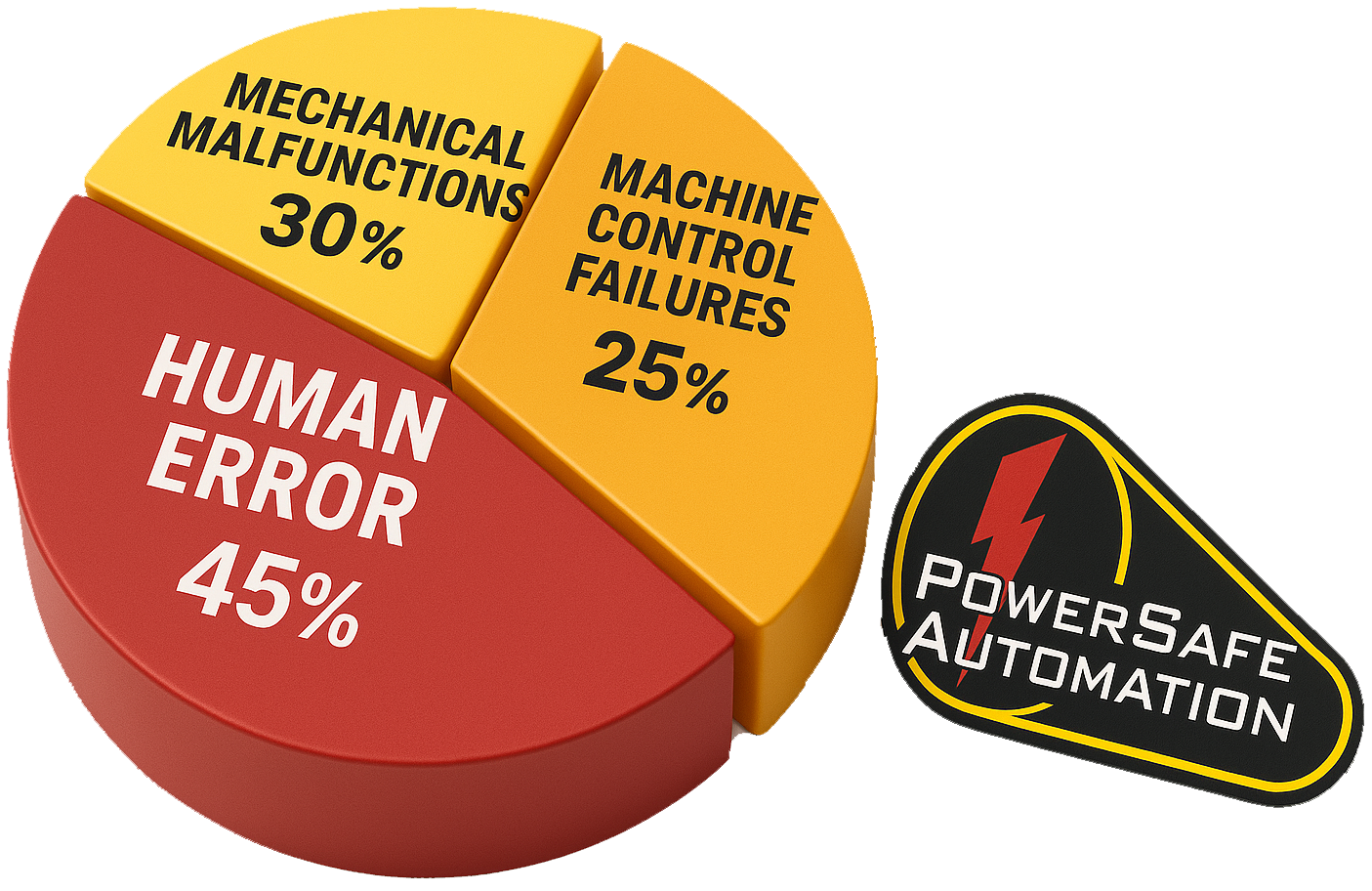Introduction: Why Machines Sometimes Make Mistakes
When most people think of mistakes in the workplace, they picture human errors, such as an operator pressing the wrong button, skipping a step, or becoming distracted. But what about when the machine itself makes a mistake? Modern manufacturing systems are fast, powerful, and increasingly automated. That does not mean they are infallible. A control system can fail, a sensor can misread, or a program can run incorrectly. When this happens, operators, maintenance teams, and nearby employees are at risk of serious injury.
The question is: how do we safety guard against mistakes committed not by people, but by machines or their controls?
This post explores that topic in depth, offering manufacturers, safety managers, and engineers clear strategies for reducing risks caused by machine or control errors.
Understanding the Nature of Machine Mistakes
Machines do not make mistakes in the way humans do, but they can produce unintended outcomes for several reasons:
- Mechanical failure – A worn gear, loose fastener, or fatigued component can cause abnormal movement.
- Electrical faults – Wiring errors, short circuits, or power surges can trigger unintended actions.
- Control system glitches – PLC programming errors, software bugs, or corrupted data may cause incorrect sequences.
- Sensor or feedback errors – Misaligned photo eyes, faulty encoders, or dirty safety scanners can misread inputs.
- Environmental factors – Dust, heat, humidity, or vibration can degrade control performance.
Recognizing that machines are not immune to error is the first step in designing effective safety guarding strategies.
The Consequences of Uncontrolled Machine Errors
When a machine or its controls malfunction, the outcomes can be unpredictable. Common consequences include:
- Unexpected start-up – A motor suddenly energizes without warning.
- Failure to stop – A stop command is ignored or delayed.
- Improper movement – A robotic arm moves outside its programmed path.
- Inconsistent outputs – A machine produces faulty parts, leading to jams or secondary hazards.
These mistakes not only risk serious worker injuries but can also result in OSHA citations, costly downtime, and damaged equipment.
OSHA and ANSI Guidance on Machine Control Failures
Regulators recognize the reality of machine and control errors. OSHA’s general machine guarding standard (29 CFR 1910.212) requires employers to protect operators and employees from hazards created by the machine itself, including unintended operations.
Additionally, ANSI B11 standards provide detailed frameworks for risk assessment, guarding design, and functional safety. These emphasize control reliability, meaning the system should default to a safe state in the event of failure.
Core Principles of Guarding Machine Mistakes
How can manufacturers guard against errors committed by machines and controls? It comes down to a few essential principles:
- Fail-Safe Design – Systems must default to a safe state (stopping motion, de-energizing power) if an error occurs.
- Redundancy – Critical safety functions should not depend on a single device or program line.
- Diverse Safeguarding – Use a combination of physical guards, electronic devices, and administrative controls.
- Verification and Testing – Regular testing ensures that safety systems work as designed.
- Human Oversight – Even automated systems need trained personnel to monitor and intervene.
Types of Safety Guarding That Protect Against Machine Errors
- Physical Guards
- Electronic Safety Devices
- Functional Safety Systems
Traditional guards such as fixed barriers, interlocked doors, and adjustable shields are still vital. They prevent direct access to dangerous areas if the machine misbehaves.
- Fixed guards – Permanently attached barriers that block access to dangerous points of operation.
- Interlocked guards – Doors or panels wired so that opening them immediately stops the machine.
- Adjustable guards – Shields that allow flexibility while still protecting operators.
Modern safeguarding relies heavily on electronics, particularly when guarding against control failures.
- Light curtains – Stop hazardous motion if a beam is interrupted.
- Safety laser scanners – Detect personnel in a programmed zone and stop operation.
- Two-hand controls – Ensure operators’ hands are clear during activation.
- Safety mats – Trigger shutdown when someone steps into a danger zone.
These devices are often wired into safety relays, safety controls, or safety PLCs that ensure redundancy and reliability.
Functional safety focuses on the control system itself. It answers the question: what happens if the control system fails?
- Safety-rated PLCs – Controllers certified for safety applications.
- Dual-channel wiring – Two independent paths that both must agree for operation.
- Emergency stop circuits – Hardwired, fail-safe, and evaluated regularly.
- Safe torque off (STO) – Drives that cut energy to motors instantly in fault conditions.
- Redundancy and Diagnostics
- Just because no one has gotten hurt, does not mean you are safe.
A single-point failure should never create a dangerous condition. That is why redundancy (two devices doing the same job) and diagnostics (detecting and responding to failures) are core to guarding against machine mistakes.
Real-World Example: When Controls Fail
Imagine a packaging machine where a sensor incorrectly detects a box, triggering a cutter to operate without material in place. The cutter could cycle with nothing under it…dangerous if a worker’s hand is nearby.
Without guarding, this could result in an amputation. With guarding:
- A light curtain prevents machine motion if hand enters the cutter zone.
- A safety controller monitors the sensor and shuts down if readings are inconsistent.
- An interlocked door ensures maintenance staff cannot access moving parts.
This layered approach prevents a single control error from turning into a catastrophic injury.
Integrating a Risk Assessment into Machine Guarding Strategies
No two machines are the same. That is why a machine-specific risk assessment is essential.
The process includes:
- Identify hazards – Points of operation, motion hazards, stored energy.
- Assess severity and likelihood – What injuries could occur, and how often?
- Evaluate existing safeguards – Are they adequate? Do they cover control errors?
- Prioritize actions – Address the highest risks first.
- Implement and verify – Install new safeguards and confirm effectiveness.
By following this structured method, manufacturers ensure that safety guarding is not just reactive but proactive.
Training and Awareness: The Human Element
Even the most advanced safety guards require people who understand their role. Training should emphasize:
- Why controls can fail – Helping employees recognize abnormal machine behavior.
- How to use emergency stops – Everyone should know where they are and how they work.
- Lockout/Tagout (LOTO) – Ensuring safe maintenance when controls are unreliable.
- Reporting system issues – Encouraging prompt reporting of unusual machine responses.
Common Mistakes to Avoid in Guarding Against Machine Errors
- Relying on one guard only – A single device may fail. Always use layers.
- Skipping regular testing – Safety circuits must be frequently verified.
- Ignoring software risks – Bugs in PLC code can be just as dangerous as broken hardware.
- Not updating after modifications – Any machine change requires re-validation of safety.
- Assuming “it can’t happen here” – Every facility is vulnerable to control errors.
The Cost of Inaction
Some managers see guarding against machine mistakes as optional until an incident proves otherwise. The costs can be staggering:
- Medical costs and workers’ compensation – Injuries can lead to six-figure payouts.
- OSHA penalties – Serious violations average thousands per incident.
- Downtime and lost production – A single accident can halt operations for days.
- Reputation damage – Unsafe practices drive away employees, customers, and investors.
Investing in robust safety guarding is not just compliance, it is good business or best practice.
Looking Ahead: Smarter Machines, Smarter Guarding
As machines become more connected and intelligent, new opportunities arise for preventing errors:
- Predictive maintenance – Sensors detect wear before failures occur.
- AI-based monitoring – Systems learn “normal” behavior and detect anomalies.
- Remote diagnostics – Engineers can troubleshoot control issues quickly.
- Integrated safety networks – Safety devices communicate seamlessly across systems.
The future of machine safety will rely not just on barriers and buttons, but on intelligent systems that anticipate and prevent errors before they occur.
Conclusion: Building a Safety Net for Machine Errors
Machines and their controls can and do make mistakes. Left unchecked, these errors can injure workers, shut down production, and cost companies dearly. The good news is that proven strategies exist to guard against them.
By combining:
- Risk assessments
- Physical machine guards
- Electronic safety devices
- Functional safety controls with redundancy and diagnostics
- Proper installation and integration
- Preventative maintenance for ongoing verification
- Ongoing training
Manufacturers can build a resilient safety net that protects workers from the unpredictable nature of machine and control errors. At the end of the day, safety guarding is not just about protecting against human mistakes. It is about acknowledging that even the best machines can fail and designing systems that ensure when they do, people remain safe.

Learn the difference between a Safety Solutions Provider vs. a Component and Fencing Supplier.



